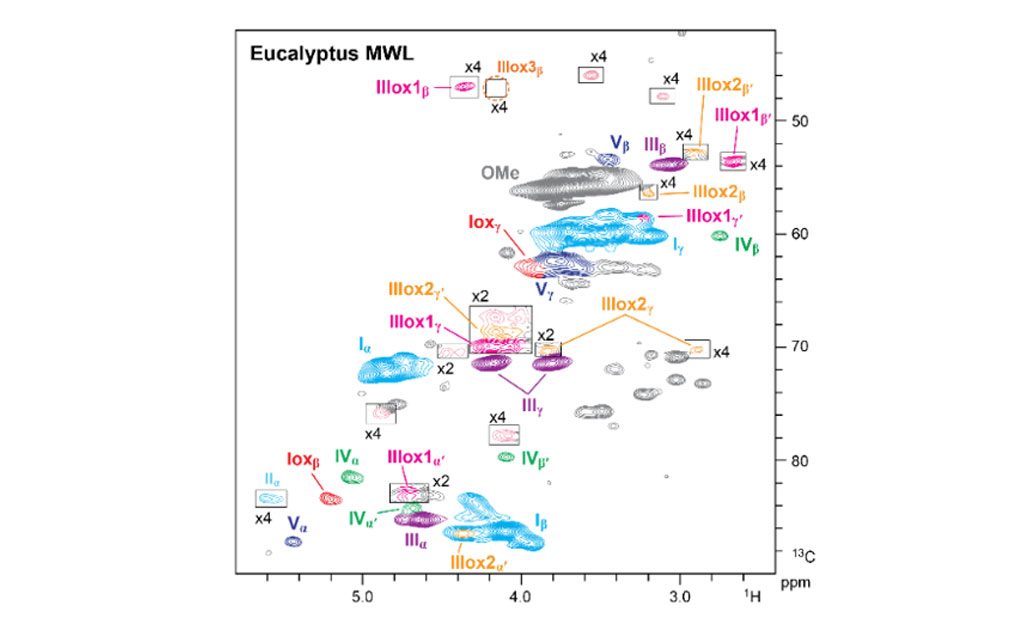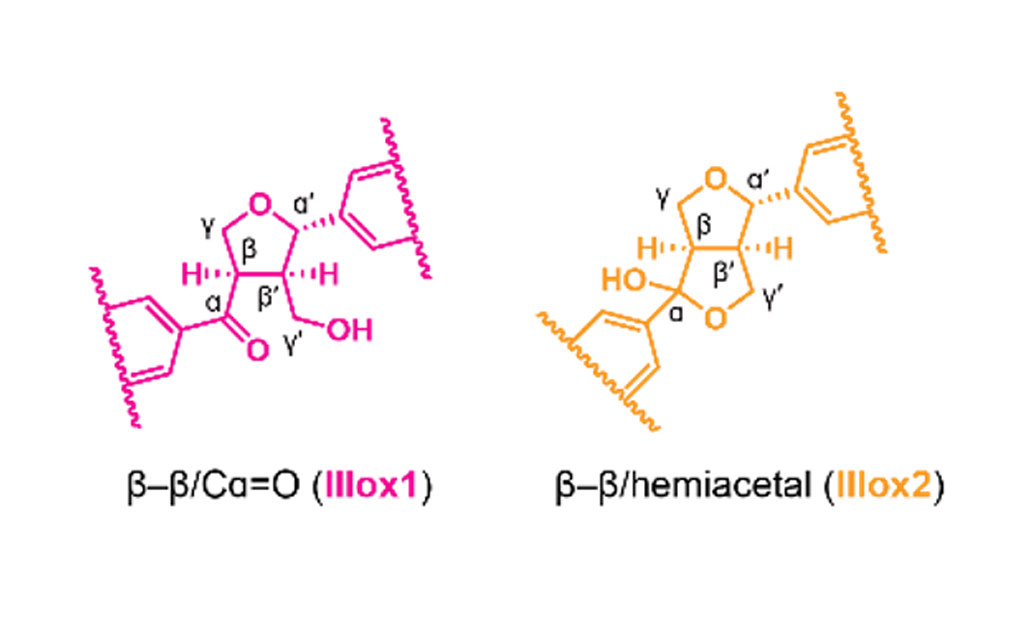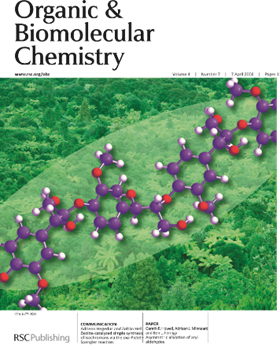Papers
主な研究成果を紹介します。各教員の研究業績は、メンバー/MemberのところからResearchmapをご確認ください。
リグニンの重合機構と化学構造
シリンギルリグニンの初期重合機構の解明
Elucidation of the initial polymerization mechanism of syringyl lignin
広葉樹リグニンの初期重合機構の解明を行うため、シリンギルリグニンのモノマーであるシナピルアルコールの酵素脱水素重合の際に、フローマイクロリアクター(FMR法)と過酸化水素の量を制限した滴下法を取り入れました。その結果、シリンギルリグニンの形成では、シナピルアルコールの二量化によりまずβ-β二量体が生成し、その後erythro選択的にβ-O-4構造で伸長することがわかりました。
To elucidate the initial polymerization mechanism of syringyl lignin, peroxidase-catalyzed dehydrogenative polymerization of sinapyl alcohol (SA), a syringyl lignin monomer, was conducted using a flow microreactor (FMR) method and the Zutropf (gradual addition of SA) method with limited amounts of H2O2. The results showed that dimerization of sinapyl alcohols first produces a β-β dimer, followed by erythro-selective formation of the β-O-4 structure in the syringyl lignin formation.
Yamaguchi, A.; Kishimoto, T.; Urabe, D. Initial Stage of Syringyl Lignin Formation from Sinapyl Alcohol. J. Agric. Food Chem., 71(40), 14666-14677 (2023). DOI:10.1021/acs.jafc.3c03402

Initial formation mechanism of syringyl lignin
広葉樹リグニンの新規部分構造の発見
Discovery of a new substructure of hardwood lignin
広葉樹リグニンのモノマーであるシナピルアルコールを、ラッカーゼを用いて脱水素重合すると、α-カルボニル型β-β二量体(IIIox1)とそのヘミアセタール型二量体(IIIox2)が生成することが分かりました。さらに、これらの部分構造が、ユーカリやアカシアなどの広葉樹リグニン中に存在することを新たに見いだしました。これらのα-カルボニル構造は細胞壁中でのリグニンの重合反応により生成すると考えられます。
Dehydrogenative polymerization of sinapyl alcohol, a hardwood lignin monomer, with laccase has been found to produce dimers with α-carbonyl β-β structure (IIIox1) and its hemiacetal structure (IIIox2). Furthermore, we found that these substructures exist in hardwood lignins such as Eucalyptus and Acacia. These α-carbonyl structures are thought to be generated by the polymerization reaction of lignin in the cell wall.
Kishimoto, T., Hiyama, A., Yamashita, A., Tobimatsu, Y., Takano, T., Urabe, D. Existence of syringyl α-carbonyl-type tetrahydrofuran β–β structure in hardwood lignins.ACS Sustainable Chemistry & Engineering, 10(37) 12394-12401 (2022). DOI: 10.1021/acssuschemeng.2c03861


β-O-4型人工リグニンポリマーの合成
Chemical synthesis of β-O-4 type artificial lignin
リグニン中で最も多い結合であるβ-O-4結合のみでできた人工リグニンポリマーの合成に成功しました。これまで、2量体モデル化合物などで検討されてきたリグニンの主要構造の反応性や特性を、高分子の観点から再検討することが可能となりました。
We have succeeded in synthesizing an artificial lignin polymer composed solely of β-O-4 bonds, the most abundant bonds in lignin. The reactivity and properties of the major structures of lignin, which have been studied in dimeric model compounds, can now be re-investigated from the viewpoint of polymers.
Kishimoto, T, Uraki, Y., Ubukata, M. Chemical synthesis of β-O-4 type artificial lignin.Org. Biomol. Chem., 47(7) 1343-1347, 2006. DOI: 10.1039/b518005h


微生物による環境浄化
廃プラスチック類の分解を目指した環境汚染物質分解細菌の利用
Utilization of xenobiotic-degrading bacteria for the biodegradation of waste plastics
様々なビフェニル/PCB分解細菌の内、裁断したペットボトル (PET 片) を唯一の炭素源として生育する株を発見しました。また、これらのビフェニル/PCB分解細菌のゲノム情報を精査するとプラスチック類やその原料成分の分解に関与すると推定される遺伝子を多く有していることが分かりました。さらに、PET 片に物理化学的な前処理を行うと菌の生育や PET 片への菌の付着性の向上が確認されました。
Among various biphenyl/PCB-degrading bacteria, we discovered a strain that can grow using only shredded PET bottles (PET flakes) as the sole carbon source. Furthermore, genome analysis of these biphenyl/PCB-degrading bacteria revealed that they possess numerous genes predicted to be involved in the degradation of plastics and their raw components. Additionally, physical and chemical pretreatment of PET flakes enhanced bacterial growth and adhesion to the surface of the PET flakes.
渡邊崇人 プラスチック廃棄物の微生物分解の効率化を目指した生化学・工学的アプローチ.IFO Res. Commun. 37, 151 (2023)./ Watanabe, T. Biochemical and engineering approaches to enhance microbial degradation of plastic waste, IFO Res. Commun. 37, 151 (2023). (in Japanese)

Biphenyl/PCB-degrading bacteria growing on shredded PET bottles (PET flakes)
- Inorganic salt liquid medium with added PET flakes (uninoculated)
- Inorganic salt liquid medium with added PET flakes (inoculated with bacteria)
- Inorganic salt liquid medium with added physically and chemically pretreated PET flakes (inoculated with bacteria)
